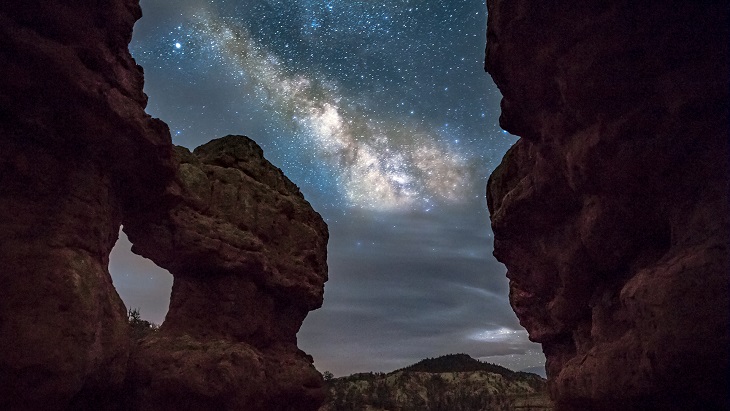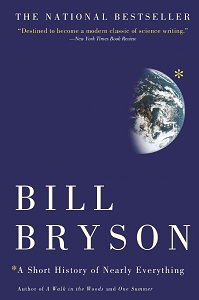Review: A Short History of Nearly Everything

“Not one of your pertinent ancestors was squashed, devoured, drowned, starved, stranded, stuck fast, untimely wounded, or otherwise deflected from its life’s quest of delivering a tiny charge of genetic material to the right partner at the right moment in order to perpetuate the only possible sequence of hereditary combinations that could result—eventually, astoundingly, and all too briefly—in you.”
A Short History of Nearly Everything is not as impossibly far-reaching as the title would indicate. An attempt to cram everything and the kitchen sink into a work intended for the general reader is surely a recipe for failure — or so one might think. Bryson marshals science, history, and philosophy to present a big-picture understanding of our universe from past to present. Extraneous details are filtered out, and mysteries left unexamined, yet it somehow feels complete. Not unlike a film editor who can cut down 24 hours of production material into a feature-length film, he manages to pack a world of wonder and insight into an accessible and entertaining, though relatively lengthy (544-page) tome.
Bryson’s preoccupation is less with the rote repetition of facts (though there is that, too) than with conveying just how it is we know what we know. He takes us behind the curtain for a more intimate look at the process of discovery and the strokes of genius essential to that process.
Lengthy and mildly scatterbrained it might be, ASHONE is a pure literary delight. The author’s excitement and enthusiasm for the subject matter drip from every page. The sheer joy he receives from learning little gems he missed in high school or being reintroduced to information forgotten long ago is intoxicating. He meets with a wonderful cast of men and women to highlight the personalities behind the stories of discovery. Lone geniuses are a rarity in any field, and science is no exception. Bryson scratches below the surface to meet the individuals who played prominent roles yet went unrecognized.
In taking the long view, Bryson engages some of science’s toughest questions. Everything from the Big Bang to man’s (relatively terse) evolutionary past is presented here, with a nod to some of the more eminent and intriguing figures from each field. I particularly appreciated that after a concept was explained, he immediately followed up with the most obvious question in response. It really helps the lay reader navigate these complex topics.
Bryson spends a good amount of time on natural disasters, describing the assorted ways they shaped the history of our planet. His frequently humorous analogies help you understand their sheer scale and the havoc left in their wake. Ice ages, earthquakes, supervolcanoes, and pandemics are each showcased in breathtaking detail in some of the most harrowing events on planetary record. Given all the chaos that has besieged our planet, it becomes soberingly clear by the book’s end that we humans — or any life for that matter — are incredibly lucky to be here. In light of all that can go wrong and has gone wrong, it’s remarkable there is any life left to comment on the tragedy and storied disarray. I commend Bryson for demonstrating how truly diminutive our time here on Earth is relative to the universe’s imponderably vast history.
Bryson should also be applauded for pointing out places where our inquiry has hit a brick wall or those areas that remain imperfectly understood. The fact that we have accumulated such vast storehouses of knowledge over the last few centuries does not mean there are no mysteries left to explore. Indeed, dozens of questions both big and small remain unanswered, and new discoveries have a tendency to open up several more. We can both be proud about what we have uncovered to date and humble about the many uncharted possibilities that surely await us.
Fast and Loose with Science
There are a few caveats, however, with respect to some of the finer details. In one place he describes particles with “spin” as actually rotating about an axis (they are not). This erroneous conception of elementary particles dates back to the 1920s, when George Uhlenbeck and Samuel Goudsmit interpreted the motion of electrons as self-rotation around their own axis. A few years later, Paul Dirac pointed out that electrons could not be spinning according to the rules of orbital angular momentum because the rate at which their surface would have to be spinning (to produce the magnitude of the magnetic moment) would have to exceed the speed of light, which would violate the special theory of relativity.
In another place Bryson says that quantum entanglement is a violation of relativity (it is not). Relativity tells us that nothing can travel faster than the speed of light, and this applies even to things with zero mass, such as information or other electromagnetic radiation. Entanglement says that measuring a particle in one place can instantly affect a particle somewhere else. However, this effect is constrained by the cosmic speed limit. On p. 42 of his book What Is Relativity?, Jeffrey Bennett responds to this notion:
Bryson also claims that the production of black holes within particle accelerators like the Large Hadron Collider could destroy the world, when in fact, these microscopic black holes would disintegrate in nanoseconds thanks to Hawking radiation. On p. 154 of the same book, Bennett also debunks this largely media-driven fear:
In case you are wondering how a micro black hole could be “safe,” the most likely answer has to do with a process called Hawking radiation…Hawking showed that the laws of quantum physics imply that black holes can gradually “evaporate” in the sense of having their masses decrease, even while nothing ever escapes from within their event horizons. The rate of evaporation depends on a black hole’s mass, with lower-mass black holes evaporating much more rapidly. The result is that while the evaporation rate would be negligible for black holes with star-like masses or greater, micro black holes would evaporate in a fraction of a second, long before they could do any damage.”
He may have consulted with experts, but the manuscript could have benefited from additional fact-checking. That said, although the book was published in 2003, there is little that is out of date as of this writing — the confirmed interbreeding between Neanderthals and Denisovans being one notable discovery of late that adds greater texture to the stories recounted here. I also feel there could (and should) have been a greater emphasis on climate change; Bryson seemed to skirt over it whenever a related topic arose, and it’s not clear whether this was intentional.
Closing Thoughts
The content in ASHONE is something I think everyone should know and be exposed to, and it’s hard to imagine the material presented with greater alacrity than it is here. The passion and unbridled enthusiasm on display frequently approaches Sagan-esque proportions, in a style redolent of the signature series Cosmos, which is about the highest praise a work in this genre could hope to achieve. Though I found a few errors — and suspect the average grad student in one of a number of the subjects covered could spot a handful more — the book is nevertheless a praiseworthy stab at science writing for the layperson. Bryson set an ambitious task for himself and ultimately delivered a lively, accessible, and mostly scientifically faithful, albeit cursory, proem to the history of the universe as we know it today.
Note: This review is mirrored over at Goodreads and at Amazon.
Feature image: Milky Way on The Rocks by brennanvisuals
Explore further: A Brief History of Everything, feat. Neil deGrasse Tyson



Comments